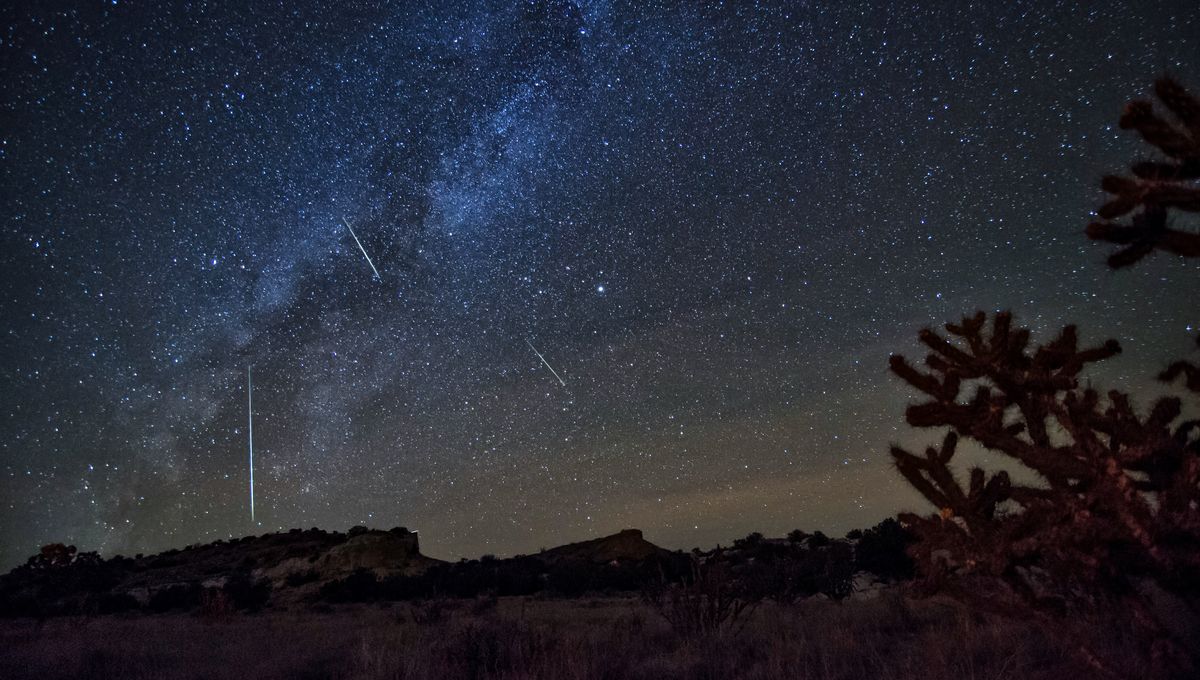
Throughout October early risers get to see more meteors than usual, thanks to several showers, particularly the Orionids. The Orionids are one of the longer meteor showers, being seen from October 2 to November 7; but like all showers they have a peak when the sky show is best, and that’s usually on October 21 or 22. Unfortunately for most of us, Orion doesn’t rise until well after midnight at the moment, so catching the Orionids takes extra effort.
Meteor showers (with one exception) are caused by dust trails left behind by comets, for now. When the Sun’s warmth turns some of their ice to gas, the streams pushed by the solar wind carry some dust and tiny stones with them.
The pressure of the solar wind and the impulse of the gas alter the dust particles’ paths, but most don’t stray too far from the comet’s orbit, creating a cloud the Earth runs into at the same point each year.
When this happens, the high relative velocity of the dust particles means they burn up in Earth’s atmosphere with surprising brightness for something so small.
The Orionids are one of two showers each year composed of the debris from Halley’s Comet. Even though the comet is now beyond Neptune, having just passed its furthest point from the Sun and begun its return, both showers keep showing up. Halley being the most famous of the visitors to the inner Solar System, this gives the Orionids a sentimental status that sets them apart from other showers. Orionids is also an easier name to remember than Eta Aquariids, Halley’s other child.
The meteors in a shower can be distinguished from the regular sort because they appear to radiate from a particular point in the sky. Each shower is named after the constellation in which this radiant appears. As you’ve probably guessed, for the Orionids that is in Orion, but only just. The Orionids appear to come from near the northernmost point of Orion, near the hand of the upstretched arm of which Betelgeuse represents the shoulder.
That location has the advantage of being visible to most of the world, unlike many meteor showers that are one hemisphere only. Sitting 10 degrees from one of the sky’s most famous and recognizable stars, makes it easy to know where to look.
The downside of this shower is that Orion rises so late in the night at the moment that you need to get up early to see these cosmic crumbs ping across the sky. It’s particularly tricky for those in the Southern Hemisphere, where the Sun is now rising early enough that while it is still dark most of the meteors will still be quite low in the east.
On the other hand, there are two additional attractions this year. Jupiter and Mars are both currently quite close to the Orionid’s radiant, offering plenty to look at while waiting for the next meteor. Unfortunately, the Moon will also be nearby, and still close enough to full to make it hard to spot the fainter meteors.
Every shower has its own character including meteor speed, brightness distribution, and sometimes color. Some are tightly bunched, offering a short but glorious burst of fireworks; others are stretched out with a gentle rise to peak numbers before falling again. Still others have bursts at unpredictable times.
Showers are measured by the Zenith Hourly Rate (ZHR) – the number of meteors one would see under dark skies if directly under the radiant. The Orionids ZHR is no match for the year’s big three meteor showers, the Geminids, Quadrantids, and the Perseids. Nevertheless, in recent years ZHRs of 25-37 have been reported by observing cameras, at peaks that occurred on either October 21 or 22.
The Orionids is one of the longer showers, and the October show is enhanced by overlap with many small showers, so even if you miss the peak, there could still be good shows the following mornings. By comparison, December’s Geminids have many more meteors at the peak, but offer little to those a day or two late.
Source Link: Orionids Meteor Shower Peaks Monday Morning Bringing A Trace Of Halley’s Comet